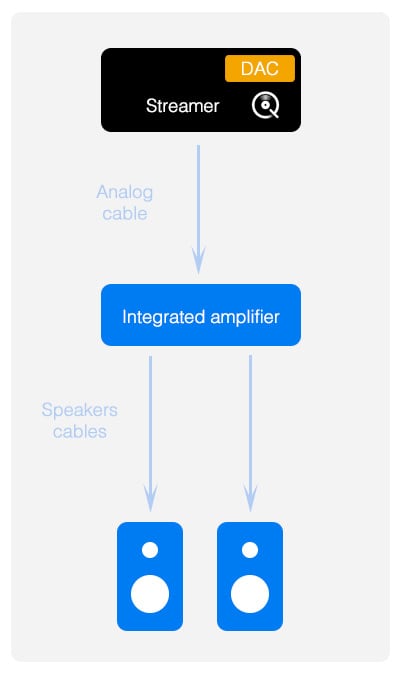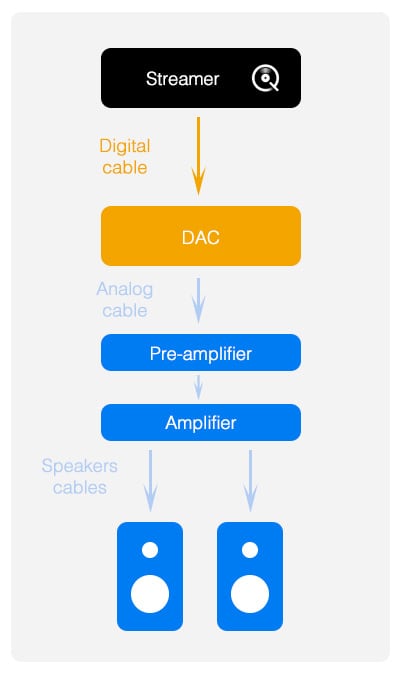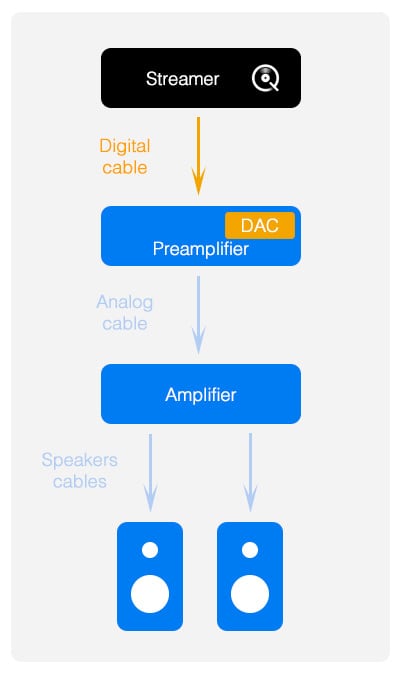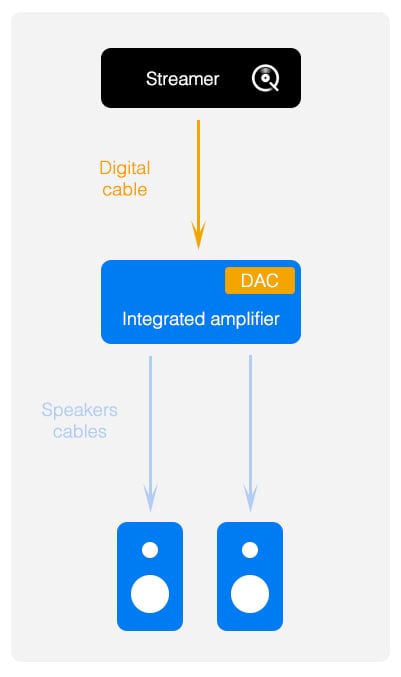A HiFi system can contain a vast number of components if you choose to dedicate a device to each individual function. Let’s start off by defining the relevant devices before we go on to explore the different options with some example setups.
What is a DAC?
Whether it’s part of a HiFi system or a PC setup, the purpose of a DAC (Digital to Analogue Converter) is to convert a digital audio signal into an analogue one. DACs receive a music streamer’s digital audio output as input.
What is a preamp?
A preamp usually has two core functions: source selection (music streamer, vinyl, CD…) and volume control. As such, it has controls on the front panel or on an infrared remote control.
What is a power amp?
You can’t connect your speakers directly to a preamp since the latter can only transmit a preamplified audio signal to a power amp. The preamp is connected to the power amp via RCA or XLR cables, and then the speakers are connected to the amplifier.
What is an integrated amp?
An integrated amp is a preamp and a power amp rolled into one device. It handles source selection, volume control and amplifies the signal to the speakers.
What is a DAC/preamp?
In addition to converting the digital signal to analogue, a DAC/preamp also incorporates a source selector and volume control. Combining these functions into one device means you can simply connect the power amp of your choice directly to it.
Integrated mp with DAC
This is the most comprehensive all-in-one solution. Taking the form of an integrated amp equipped with digital inputs, it also contains a DAC. This multi-functional device handles conversion, preamplification and amplification.




Which Solution is Best for Me?
You’re probably wondering which of the above solutions is best for you. Contrary to popular belief, the optimum solution isn’t necessarily the one that entails dedicating a device to each individual function, though this might be the best option if you have the space to accommodate them all. You’ll also need the knowledge to determine the best possible device pairings since each one has its own specific requirements. It’s a good bet to visit your go-to retailer and test out different product combinations.
If you’re looking for the perfect compromise between quality and complexity, then the DAC/preamp is definitely worth considering. There’s a broad array of choices within this category, from the most simple and accessible products to fully comprehensive, exclusive models. This device will vary in terms of the number of digital inputs for the DAC and the analogue inputs for the other sources. Some models even provide an HDMI ARC port for connecting TV and video sources. You can also find HiFi DAC/preamps that have an automatic audio calibration system. In this case, all you need to do is connect the DAC/preamp to a power unit that’s adapted to your speakers, or even directly to active speakers.
The easiest way to do this is to connect your music streamer to an integrated amp with digital inputs. Though they used to be a rare find, it’s now very common to come across amps with built-in DACs. Your model might already be equipped with one without you even knowing. It’s also worth noting that all integrated home cinema amps are equipped with digital audio inputs.
Make sure you choose a device with a digital/analogue conversion stage that’s compatible with the audio quality of the streams and files you usually listen to: support for Hi-Res 192/24 or higher, MQA and/or DSD formats.
Whichever solution you choose, DAC, DAC/preamp or integrated amp with DAC, the digital output format of your music streamer needs to be correctly supported. Optical, coaxial, AES, I2S or USB: the chosen conversion solution must offer the corresponding connector.
What about the analogue output of music streamers?
Music streamers process audio streams or digital files, and they often require a digital input. This signal can be picked up and converted to analogue by another device in the system.
However, there are many music streamers that also contain an analogue output. You’ve guessed it: they include a DAC! The analogue output can be connected directly to a preamp or a classic integrated amp without the need for a DAC.
This kind of connection is super easy to manage. Just be aware that a music streamer’s digital-to-analogue conversion isn’t necessarily its strong suit. After all, this isn’t its primary function.
To sum up, a music streamer with an analogue output is sufficient for many setups. If you want to go a step further and improve your system, then entrust this conversion to an external DAC, whether it’s a stand-alone device or part of a preamp or integrated amp.